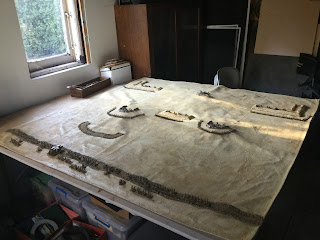The approach I took was to:
1. Paint a plastic backed canvas dropsheet with an undercoat of off white acrylic house paint
2. Once dry, scrape on a thin layer of grey caulking compound (painting first meant less compound was lost in the porous canvas - used less product!)*
3. Sprinkle with fine grit while soft (I used sand)
4. Once dry, paint with an acrylic house paint again - sand coloured - then dry brush with a range of other suitable colours - eg. browns and greys
*Its worth hiughlighting Lasgunpacker's comment below - there may be a durability issue with the latex not bonding as well to ;pain as it would to the canvas - good point, time will tell!
Here's what it looks like with some minis on it:
I have 6mm Irregular and 15mm Eureka Miniatures minis on the painting bench for some WW2 Operation Compass gaming - the 15mm are the Eureka range sculpted as the Australian 6th Division at Bardia. However, below I have laid out some of the Eureka Miniatures World War 1 Palestine range in preparations for a Second Battle of Gaza scenario.
I have since completed a platoon of Bersaglieri, again from Eureka. The next step is to get them on the table for a little Operation Compass 'fun' using my recent purchase of Iron Ivan's Disposable Heroes.



















































